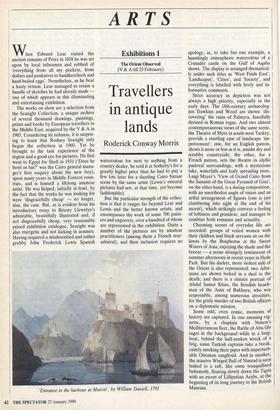ARTS
Exhibitions 1
The Orient Observed (V & A till 25 February)
Travellers in antique lands
Roderick Conway Morris
When Edward Lear visited the ancient remains of Petra in 1858 he was set upon by local tribesmen and robbed of 'everything from all my pockets, from dollars and penknives to handkerchiefs and hard-boiled eggs'. Nonetheless, as he beat a hasty retreat, Lear managed to retain a bundle of sketches he had already made one of which appears in this illuminating and entertaining exhibition.
The works on show are a selection from the Searight Collection, a unique archive of several thousand drawings, paintings, prints and books by European travellers to the Middle East, acquired by the V & A in 1985. Considering its richness, it is surpris- ing to learn that Rodney Searight only began the collection in 1960. Yet he brought to the task experience of the region and a good eye for pictures. He first went to Egypt for Shell in 1931 ('Does he bowl or bat?' was the Cairo general mana- ger's first enquiry about the new boy), spent many years in Middle Eastern coun- tries, and is himself a lifelong amateur artist. He was helped, initially at least, by the fact that the works he was looking for were 'disgracefully cheap' — no longer, alas, the case. But, as is evident from his introductory essay to Briony Llewelyn's admirable, beautifully illustrated and, if not disgracefully cheap, very reasonably priced exhibition catalogue, Searight was also energetic and not lacking in acumen. Having acquired a misdescribed and rather grubby John Frederick Lewis Spanish watercolour for next to nothing from a country dealer, he sold it at Sotheby's for a greatly higher price than he had to pay a few lots later for a dazzling Cairo bazaar scene by the same artist (Lewis's oriental pictures had not, at that time, yet become fashionable). But the particular strength of the collec- tion is that it ranges far beyond Lear and Lewis and the better known artists, and encompasses the work of some 700 paint- ers and engravers, over a hundred of whom are represented in the exhibition. Quite a number of the pictures are by amateur practitioners (among them a French rear- admiral), and their inclusion requires no 'Entrance to the harbour at Muscat', by William Daniell, 1793 apology, as, to take but one example, a hauntingly atmospheric watercolour of a Crusader castle on the Gulf of Aqaba shows. The display is arranged thematical- ly under such titles as 'West Finds East', 'Landscapes', 'Cities', and 'Society', and everything is labelled with lively and in- formative comments.
Strict accuracy in depiction was not always a high priority, especially in the early days. The 18th-century archaeolog- ists Dawkins and Wood are shown 'dis- covering' the ruins of Palmyra, fancifully dressed in Roman togas. And two almost contemporaneous views of the same scene, the Theatre of Myra in south-west Turkey, provide a startling case of landscape 'im- provement': one, for an English patron, shows it more or less as it is, amidst dry and scrubby countryside; the other, for a French patron, sets the theatre in idyllic pastoral surroundings, with a mysterious lake, waterfalls and leafy spreading trees. Luigi Mayer's 'View of Grand Cairo from the Summit of the Great Pyramid of Giza', on the other hand, is a daring composition, with an unorthodox angle of vision and an artful arrangement of figures (one is just clambering into sight at the end of his ascent), which strikingly conveys a feeling of loftiness and grandeur, and manages to combine both romance and actuality.
Charming scenes of everyday life are recorded: groups of veiled women with their children and black servants sit on the lawns by the Bosphorus at the Sweet Waters of Asia, enjoying the shade and the breeze — a scene strangely reminscent of summer afternoons in recent years in Hyde Park. But the darker, more violent side of the Orient is also represented: two Alba- nians are shown locked in a duel to the death; and there is a sinister portrait of Abdul Samut Khan, the fiendish hench- man of the Amir of Bukhara, who was responsible, among numerous atrocities, for the grisly murder of two British officers on a diplomatic mission.
Some odd, even comic, moments of history are captured. In one amusing vig- nette, by a chaplain with Nelson's Mediterranean fleet, the Battle of Abu Oir rages in the background while in a long- boat, behind the half-sunken wreck of a brig, some Turkish captains take a break, calmly smoking their pipes with imperturb- able Ottoman sangfroid. And in another, the massive Winged Bull of Nimrud is seen lashed to a raft, like some tranquillised behemoth, floating slowly down the Tigris with an escort of Lilliputian Arabs, at the beginning of its long journey to the British Museum.


























































 Previous page
Previous page